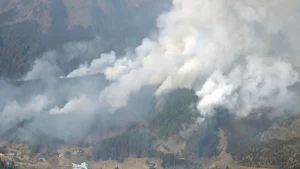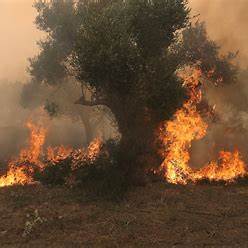🔥 Unleashing Nature’s Fury: Greek Wildfires Amid the 2025 Heatwave

Europe’s early summer of 2025 has seen a scorcher of epic proportions, pushing temperatures beyond 40°C, igniting wildfires, crumbling ecosystems, and sparking a continent-wide emergency. Among the embattled nations, Greece, particularly its iconic island of Crete, has emerged as a focal point—battling fires, evacuations, and a broader reckoning with climate extremes.
1. The Broader Heatwave Picture
This is no run-of-the-mill summer heat. Europe is engulfed in an “early summer” heatwave, with temperatures already rivaling July and August norms. Cities like Greece, Spain, Portugal, and Turkey have regularly logged highs of 46 °C, turning coastlines and olive groves into tinderboxes reuters.com+1ccstartup.com+1ft.com.
Meteorologists attribute the surge to climate change-driven sea surface warming and a persistent high-pressure heat dome. The result: intensified drought, record-high sea temperatures, and a landscape primed for disaster—a perfect storm for wildfires .
2. Greece on the Front Line
Wildfires Across the Mainland and Islands
-
Chios: Around 22 June, five fires torched parts of this Aegean island. Over 1,000 residents were evacuated; forests and homes suffered heavy damage. Arson charges were filed as at least one individual was detained en.wikipedia.org.
-
Crete (Ierapetra): The most dramatic event in early July. Roughly 1,500 people, including tourists, fled as flames threatened homes and hotels near Ierapetra. About 230 firefighters and 46 vehicles—including helicopters—were deployed amid gale-force 9 Beaufort winds reuters.com+1en.wikipedia.org+1.
-
Chalkidiki and Koropi (Attica region): Additional fires erupted or reignited around early July, forcing evacuations and stretch emergency services.
This widespread fire outbreak underscores the vulnerability of both low-risk rural zones and built-up tourist hotspots.
3. The Human Toll & Evacuations
Crete Evacuation:
-
Over 1,500 people—residents and tourists alike—were evacuated across multiple villages reuters.com+15reuters.com+15en.wikipedia.org+15reuters.com+2en.wikipedia.org+2ft.com+2ft.com.
-
Tourism operators voiced alarm, warning that summer bookings could take a major hit amid safety fears globalnews.ca.
Chios & Attica:
-
Communities faced forced displacement; vulnerable elderly and families were rushed to safety.
-
One attacker was arrested in Chios on suspicion of starting blazes intentionally .
Emergency Services on the Edge:
-
Greek firefighters—cadres of 444 personnel on Chios alone—and aerial support were stretched thin. Coordinating rescues amid strong winds and uneven terrain became critical for preventing casualties .
4. Nature’s Vengeance & Ecological Fallout
Botanical Damage:
Fires ravaged oak, pine, and olive forests—many centuries old. Once charred, regrowth will be slow, altering habitats permanently.
Coastal & Marine Threats:
Wildfires near coastlines send ash and debris into the sea, disrupting fragile marine zones and damaging algae beds that sustain fisheries and ecosystems.
Climate Feedback Loop:
Burned vegetation leads to erosion and carbon release, fueling further warming—a vicious cycle that intensifies climate extremes .
5. Heatwave Meets Infrastructure Stress
This crisis isn’t just about flames—it’s also testing European resilience systems.
-
In Italy, intense heat triggered red alerts in 18 cities.
-
Switzerland halted two nuclear reactors due to overheated river water, cutting off vital cooling sources reuters.com.
-
Riverbanks across southern Europe dried to critical lows, making fire suppression harder and downstream water shortages likelier .
6. Climate & Policy Implications
Experts Warn:
Nearly 200 scientists at the Global Tipping Points Conference emphasized that exceeding the 1.5 °C threshold risks irreversible damage to ecosystems, including forests and corals ft.com.
Urgent Action Needed:
-
Rapid emissions cuts—particularly in fossil fuels.
-
Expanded firefighting capacity, including drones, satellites, and AI-based early detection.
-
Land use reform, encouraging more fire-resilient planting and removing flammable invasive species.
7. Lessons from the Flames
-
Preparedness gaps exposed by reliance on reactive evacuations—not long-term planning or hazard mapping.
-
Public awareness is shaky. With so many tourists in Greece, better education on evacuation and prevention is crucial.
-
International coordination: Fire brigades and EU emergency assistance showed their value—but more systemic strength and funding are needed.
8. A Glimmer of Hope
-
Local volunteers and NGOs in Greece and elsewhere are pooling resources—funding firefighter aids, buying equipment, and aiding evacuees.
-
Reforestation efforts are beginning; early pilot programs explore planting with fire-resistant seedlings and native species.
-
European funding frameworks are now prioritizing climate adaptation, focusing on fire risk and forest restoration.
9. What Next?
🔥 Forecast & Firetrend:
Heatwave shows little sign of retreat. Crete, southern Greece, and Sicily are bracing for extended high fire risk. Evaporation and arid soils are creating tinder-dry landscapes.
🛡 Beyond Firefighting:
This must evolve into a climate resilience effort—combining city planning, energy policy, and land recovery across national and EU levels.
🇬🇧 Insights for the UK & Beyond
Although we’re far from Mediterranean climates, the UK is not immune. Just days ago, Scotland experienced wildfires in Moray and the Highlands—quickly followed by rain and now facing flood alerts en.wikipedia.org+1fpaigerobb.pages.dev+1thescottishsun.co.uk. These erratic extremes—fire then flood—point to the UK’s own climate vulnerability and the need for preparedness even here.
🔚 Final Thoughts
-
Greece’s wildfire crisis in early July 2025 is a stark reminder that climate change is no longer future speculation—it’s here, burning homes and transforming ecosystems.
-
Saving lives today requires better early warning, infrastructure upgrades, and emergency support. But long-term survival depends on global commitment: drastically cutting emissions, rethinking land use, and funding climate resilience.
-
The question we face is simple: Will the lessons learned from these infernos drive the policy, funding, and collective effort needed to avert next year’s disaster?



